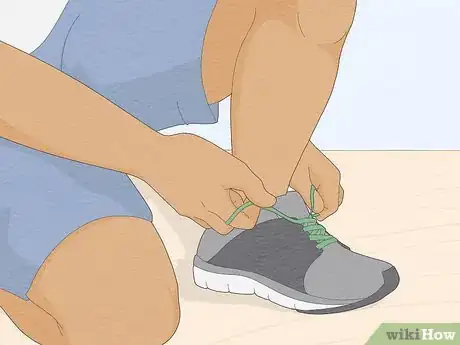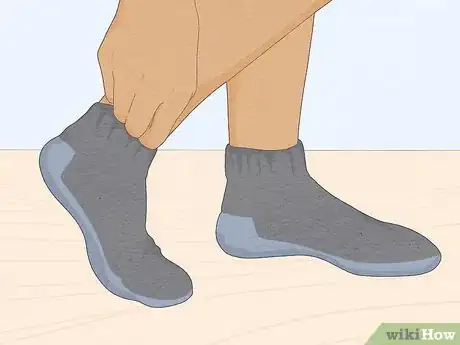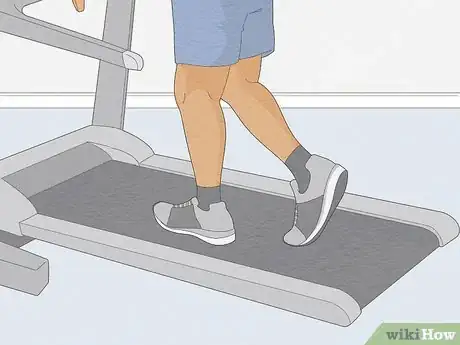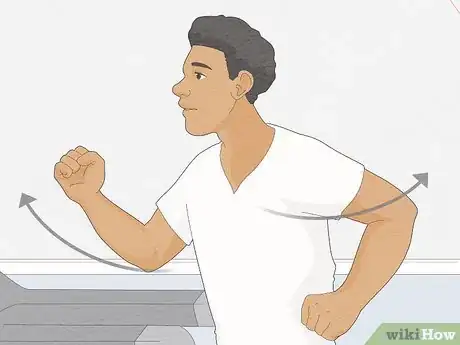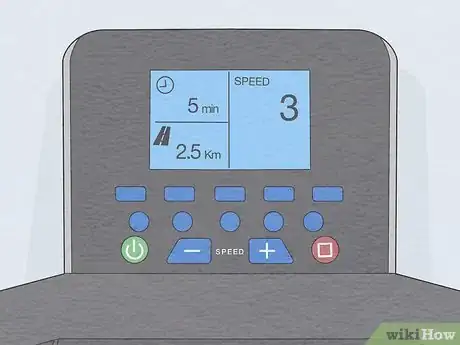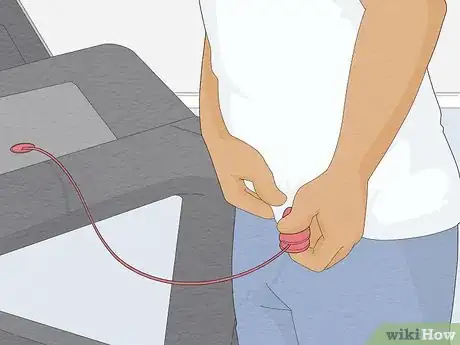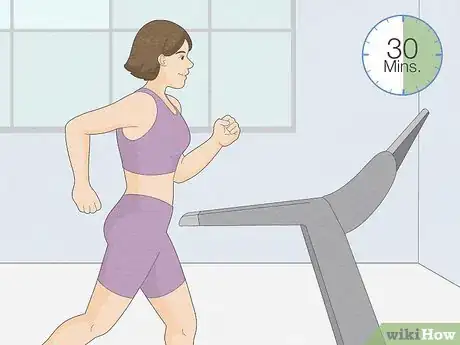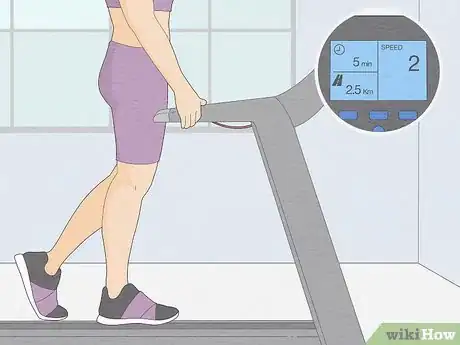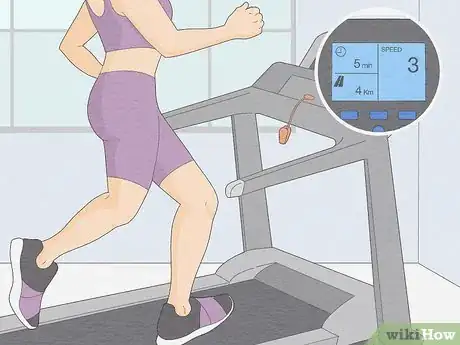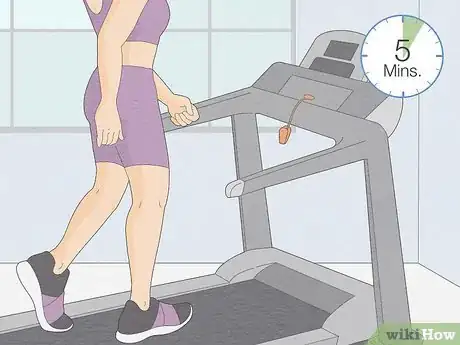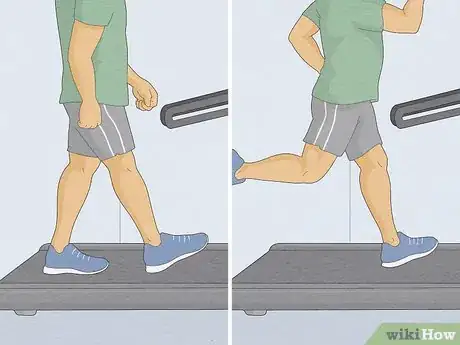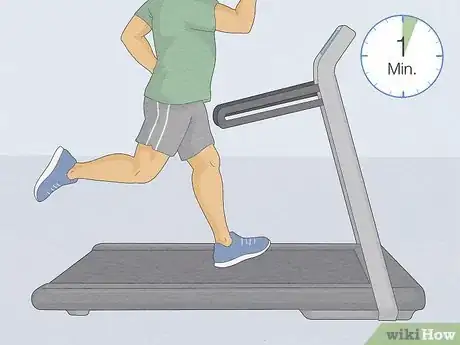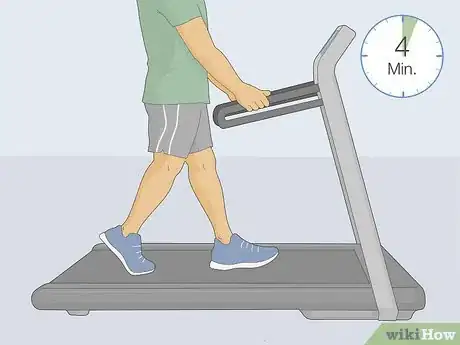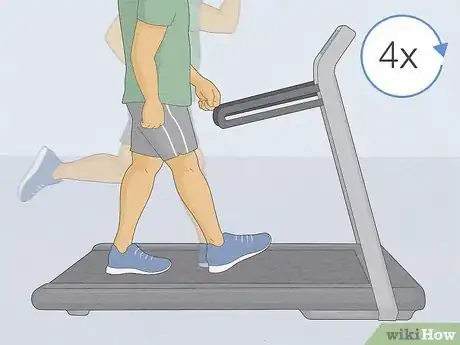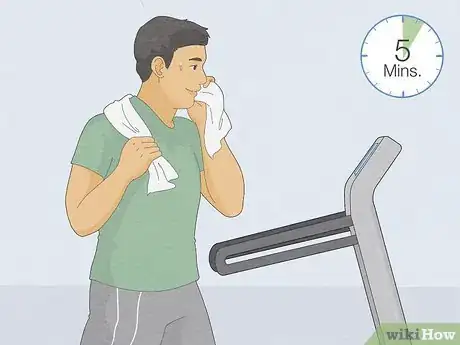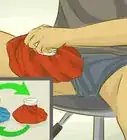This article was co-authored by Kai Ng. Kai Ng is a USATF and RRCA Certified Running Coach at Run Coach Kai. Kai has competed in over 55 races and over 15 marathons, and has trained with 16x USA and World record holder Patti Catalano Dillonso. He specializes in coaching runners of all levels and showing people that everyone can be a runner. Kai is committed to helping his clients reach their goals by showing them how to run with proper form and holding them accountable to train consistently.
There are 10 references cited in this article, which can be found at the bottom of the page.
wikiHow marks an article as reader-approved once it receives enough positive feedback. This article received 19 testimonials and 100% of readers who voted found it helpful, earning it our reader-approved status.
This article has been viewed 265,170 times.
Learning to use a treadmill requires many of the same principles of training that runners use to prepare for races. You must increase your stamina gradually, in order to avoid injury, dizziness and problems with blood pressure or dehydration. Find out how to use a treadmill by following this step-by-step guide.
Steps
General Treadmill Tips
-
1Talk to your doctor if you have joint or back problems. The doctor can specify whether you must stick with a low-impact workout (walking), or if you can do high-impact training (running).[1]
-
2Buy some comfortable running shoes. Try on as many pairs of shoes as it takes before buying any.[2] The right pair should feel cushioned, support your arches and give you room in the toes.
- Contrary to what many people think, you should not have to break-in running shoes very much. They should feel good right away, so don't settle for anything less than an extremely comfortable shoe. If possible, wear them around the house every day for a week before working out, so that you can take them back if they start to rub.
-
3Drink 16 to 24 fluid oz. (0.5 to 0.7l) of water in the 90 minutes before you do a treadmill workout.[3] Since most treadmill workouts are over 20 minutes, you can sweat heavily and suffer with dehydration later on.
- Bring a water bottle filled with at least 16 oz. (0.5l) of water with you to place on the treadmill.
- Make sure to visit the bathroom before you use the treadmill. A break in your workout can interrupt the rhythm and aerobic benefits of your workout.
-
4Wear thick socks. Try crew socks, instead of ankle socks, to avoid blisters.
-
5Warm up and cool down. Dedicate 5 minutes before and after each treadmill session to walking at a pace of 1.5 to 2 mph (2.4 to 3.2 km/h) (mph).[4]
- If you walk to the gym, this can also count as your warm up and cool down.
-
6Swing your arms. You may be tempted to hold onto the handles at the front of the treadmill to gain your balance. This will keep you from burning calories, using good posture and learning to use it properly.[5] Running either on a treadmill or outside requires good body form.
-
7Pay attention to the settings on the equipment. You should notice a speed section and an incline section where you can increase or decrease the settings. These will be the main buttons you use on the treadmill. Train on a treadmill provides speed and incline options that match your training goals. For example, you don’t want to use a treadmill that is not faster than you.
- Wait to use programmed workouts until you are comfortable with the manual settings. You will be able to customize your workout to your fitness level.
-
8Use the safety clip. Although you may choose to stop using it as you get comfortable, this clip is an emergency shut off. If you lose balance in the beginning it will keep you from falling or being seriously injured.[6]
Beginner Treadmill Workout
-
1Do a 20 to 30 minute beginner workout. For the first 15 minutes of your workout, you are most likely burning carbohydrates that you ate recently. After 15 minutes, you begin to burn body fat and build endurance.
-
2Warm up for 5 minutes. This warm up can help you to gain balance and avoid injury. Hook the safety clip to your body before starting.
- Walk at 1.5 to 2 mph (2.4 to 3.2 km/h) for 1 minute.
- Increase the speed to 1.8 mph (2.9 km/h) for the next minute. Walk on your toes for 30 seconds of that minute. Walk on your heels for 30 seconds.
- Increase the incline to 6. Remain at a speed between 1.5 and 1.8 mph (2.4 and 2.9 km/h). Walk for 1 minute.
- Take longer strides for 1 minute. If this is hard with the incline, decrease your speed. Return the incline to 0 after 2 minutes at 6.
- Increase the speed to 2.5 for the last minute.
-
3Keep a pace between 3 and 4 mph (4.8 and 6.4 km/h) for 20 minutes. You can remain at the same incline and speed during your first week of treadmill use.
-
4Cool down for 5 minutes, by slowly lowering your pace each minute.
-
5Experiment with inclines and faster speeds after the first 1 to 2 weeks.[7] You should increase the incline above level 4 for 1 to 2 minutes and return it to a slower speed. You can increase your speed by .5 mph (0.80 km/h) for 1 to 2 minutes.
- Interval training is the best way to increase endurance, speed and fat burning capacity. Intervals of 1 to 2 minutes should raise your heart rate, then you can return to a medium intensity. Medium intensity workouts are approximately at the rate where you breathe heavily but can still carry on an intermittent conversation.
- As a beginner, resist the urge to compete or to observe those around you. Run at a pace that feels natural to you.
Interval Treadmill Workout
-
1Try interval workouts with jogging or fast walking. The aim of the high intensity intervals is to raise your heart rate substantially.[8]
-
2Warm up for 5 minutes as explained above.
-
3Jog or walk quickly for 1 minute. You should aim to increase the speed of the treadmill by 1 to 2 mph (1.6 to 3.2 km/h) during this interval. People who are in good shape may be able to increase it more.
-
4Return to a pace of 3 to 4 mph (4.8 to 6.4 km/h) for 4 minutes.
-
5Do 4 more intervals, with 1 minute of high intensity jogging or walking and 4 minutes of medium intensity.
-
6Cool down for 5 minutes at the end of your workout.
- Increase your high intensity interval by 15 to 30 seconds each week.
- Try pre-programmed interval workouts once you are able to do 1 minute intervals with confidence. You can also use hill workouts to increase your intensity with incline rather than speed.
Things You'll Need
- Running shoes
- Thick, long socks
- Gym membership/home treadmill
- Water
- Safety strap
- Cool down/warm up
References
- ↑ https://www.mayoclinic.org/diseases-conditions/back-pain/symptoms-causes/syc-20369906
- ↑ https://www.webmd.com/fitness-exercise/features/how-to-buy-running-shoes-tips-to-treat-your-feet-right#1
- ↑ https://www.webmd.com/fitness-exercise/features/water-for-exercise-fitness#2
- ↑ https://www.realbuzz.com/articles-interests/running/article/warm-up-cool-down-and-stretching-for-beginner-runners/
- ↑ https://www.dummies.com/health/exercise/how-to-use-a-treadmill/
- ↑ https://www.bu.edu/today/2015/treadmill-safety-tips/
- ↑ https://www.coachmag.co.uk/exercises/1747/beginners-guide-treadmill-running
- ↑ https://www.mayoclinic.org/healthy-lifestyle/fitness/in-depth/interval-training/art-20044588
- http://www.344pounds.com/2009/06/treadmill-running-tips-for-beginners/
About this article
To use a treadmill, make sure you’re wearing comfortable running shoes to support your feet. Controls will differ from machine to machine, but you’ll find buttons to change your speed and incline. Start by walking on the treadmill, and slowly increase your speed over 5 minutes to warm up your muscles. After you’ve warmed up, maintain a pace between 3 and 4 miles per hour for about 20 minutes. Make sure you swing your arms, instead of holding the handles, since this will help you burn more calories. When you’re ready to end your treadmill session, slowly lower the pace every minute to warm down. After a few weeks of using the treadmill, experiment with faster speeds and steeper inclines for a heavier workout. For more tips, including how to practice interval training, read on!

